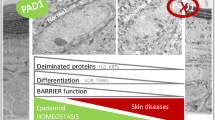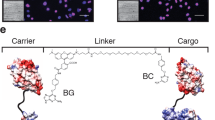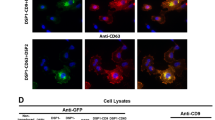Abstract
The skin is an interesting organ for human gene therapy due to accessibility, immunologic potential and synthesis capabilities. In this study, we attempted to visualize and measure the uptake of naked FITC-labeled plasmid by FACS analysis detecting up to 15% internalization in a dose- and time-dependent manner. Cycloheximide treatment inhibited the uptake by >90%, suggesting a protein-mediated uptake. The inhibition of different internalization pathways demonstrated that blocking macropinocytosis (by amiloride and N,N-dimethylamylorid) reduced DNA uptake by >85%, while the inhibition of clathrin-coated pits (by chlorpromazine) and caveolae (by nystatin/filipin III) did not limit the uptake. Colocalization studies using confocal laser microscopy revealed a time-dependent accumulation of plasmid DNA in endosomes and lysosomes. When a green fluorescent protein (GFP) expression vector was used, specific GFP-RNA became detectable by reverse transcriptase-PCR, whereas measurable amounts of protein could not be identified in FACS experiments. To detect the potential DNA receptors on the keratinocyte surface, membrane proteins were extracted and subjected to South-Western blotting using digoxigenin-labeled calf thymus and λ-phage DNA. Two DNA-binding proteins, ezrin and moesin, known as plasma membrane-actin linkers, were identified by one- and two-dimensional-South-Western blots and matrix-assisted laser desorption and ionization-mass spectrometry. Ezrin and moesin are functionally associated with a number of transmembrane receptors such as the EGF, CD44 or ICAM-1 receptor. Taken together, naked plasmid DNA seems to enter human keratinocytes through different pathways, mainly by macropinocytosis. Two DNA-binding proteins were identified that seemed to be involved in binding/trafficking of internalized DNA.
This is a preview of subscription content, access via your institution
Access options
Subscribe to this journal
Receive 12 print issues and online access
$259.00 per year
only $21.58 per issue
Buy this article
- Purchase on Springer Link
- Instant access to full article PDF
Prices may be subject to local taxes which are calculated during checkout







Similar content being viewed by others
References
Hengge UR et al. Cytokine gene expression in epidermis with biological effects following injection of naked DNA. Nat Genet 1995; 10: 161–166.
Hengge UR, Walker PS, Vogel JC . Expression of naked DNA in human, pig and mouse skin. J Clin Invest 1996; 97: 2911–2916.
Condon C et al. DNA-based immunization by in vivo transfection of dendritic cells. Nat Med 1996; 2: 1122–1128.
Fan H, Lin Q, Morrissey GR, Khavari PA . Immunization via hair follicles by topical application of naked DNA to normal skin. Nat Biotechnol 1999; 17: 870–872.
Yu WH et al. Topical gene delivery to murine skin. J Invest Dermatol 1999; 112: 370–375.
Domashenko A, Gupta S, Cotsarelis G . Efficient delivery of transgenes to human hair follicle progenitor cells using topical lipoplex. Nat Biotechnol 2000; 18: 420–423.
Udvardi A et al. Uptake of exogenous DNA via the skin. J Mol Med 1999; 77: 744–750.
Wolff JA et al. Expression of naked plasmids by cultured myotubes and entry of plasmids into T tubules and caveolae of mammalian skeletal muscle. J Cell Sci 1992; 103: 1249–1259.
Anderson RG . The caveolae membrane system. Annu Rev Biochem 1998; 67: 199–225.
Mukherjee S, Gnosh RN, Maxfield FR . Endocytosis. Physiol Rev 1997; 77: 759–790.
Kwiatkowska K, Sobota A . Signaling pathways in phagocytosis. BioEssays 1999; 5: 422–431.
Gottlieb TA, Ivanov IE, Adesnik M, Sabatini DD . Actin microfilaments play a critical role in endocytosis at the apical but not the basolateral surface of polarized epithelial cells. J Cell Biol 1993; 120: 695–710.
Marchese C et al. Receptor-mediated endocytosis of keratinocyte growth factor. J Cell Sci 1998; 111: 3517–3527.
Strous GJ, Govers R . The ubiquitin–proteasome system and endocytosis. J Cell Sci 1999; 112: 1417–1423.
Fajac I, Briand P, Monsigny M, Midoux P . Sugar-mediated uptake of glycosylated polylysines and gene transfer into normal and cystic fibrosis airway epithelial cells. Hum Gene Ther 1999; 10: 395–406.
Smith RM, Wu GY . Hepatocyte-directed gene delivery by receptor-mediated endocytosis. Semin Liver Dis 1999; 19: 83–92.
Pishvaee B, Payne GS . Clathrin coats – threads laid bare. Cell 1998; 95: 443–446.
Schnitzer JE, Oh P, Pinney E, Allard J . Filipin-sensitive caveolae-mediated transport in endothelium: reduced transcytosis, scavenger endocytosis, and capillary permeability of select macromolecules. J Cell Biol 1994; 127: 1217–1232.
Budker V et al. Hypothesis: naked plasmid DNA is taken up by cells in vivo by a receptor-mediated process. J Gene Med 2000; 2: 76–88.
McNeil PL, Vogel SS, Miyake K, Terasaki M . Patching plasma membrane disruptions with cytoplasmic membrane. J Cell Sci 2000; 113: 1891–1902.
Bennett RM, Gabor GT, Merritt MM . DNA binding to human leukocytes. Evidence for a receptor-mediated association, internalization, and degradation of DNA. J Clin Invest 1985; 76: 2182–2190.
Hefeneider SH et al. Identification of a cell-surface DNA receptor and its association with systemic lupus erythematodes. J Invest Dermatol 1990; 94: 79S–84S.
Schubbert R, Renz D, Schmitz B, Doerfler W . Foreign (M13) DNA ingested by mice reaches peripheral leukocytes, spleen, and liver via the intestinal wall mucosa and can be covalently linked to mouse DNA. Proc Natl Acad Sci USA 1997; 94: 961–966.
Gasparro FP et al. Cell membrane DNA: a new target for psoralen photoadduct formation. Photochem Photobiol 1990; 52: 315–321.
Hagstrom JE et al. Nonnuclear DNA binding proteins in striated muscle. Biochem Mol Med 1990; 58: 113–121.
Levy MY, Barron LG, Meyer KB, Szoka Jr FC . Characterization of plasmid DNA transfer into mouse skeletal muscle: evaluation of uptake mechanism, expression and secretion of gene products into blood. Gene Therapy 1996; 3: 201–211.
Hengge UR et al. How realistic is cutaneous gene therapy? Exp Dermatol 1999; 8: 419–431.
Hengge UR et al. The derivation and characterization of pig keratinocyte cell lines that retain the ability to differentiate. J Invest Dermatol 1996; 106: 287–293.
Zelphati O, Liang X, Hobart P, Felgner P . Gene chemistry: functionally and conformationally intact fluorescent plasmid DNA. Hum Gene Ther 1999; 10: 15–24.
West MA, Bretscher MS, Watts C . Distinct endocytotic pathways in epidermal growth factor-stimulated human carcinoma A431 cells. J Cell Biol 1989; 109: 2731–2739; (Erratum in J Cell Biol 110: 859).
Oka JA, Christensen MD, Weigel PH . Hyperosmolarity inhibits galactosyl receptor-mediated but not fluid phase endocytosis in isolated rat hepatocytes. J Biol Chem 1989; 264: 12016–12024.
Mirmohammadsadegh A, Maschke J, Basner-Tschakarjan E, Hengge UR . Induction of acute phase genes in keratinocytes following exposure to oligodeoxynucleotides. J Mol Med 2002; 80: 377–383.
Trigatti BL, Mangroo D, Gerber GE . Photoaffinity labeling and fatty acid permeation in 3T3-L1 adipocytes. J Biol Chem 1991; 266: 22621–22625.
Klose J . Protein mapping by combined isoelectric focusing and electrophoresis of mouse tissues. A novel approach to testing for induced point mutation in mammals. Humangenetik 1975; 26: 231–243.
Bowen B, Steinberg J, Laemmli UK, Weintraub H . The detection of DNA-binding proteins by protein blotting. Nucleic Acids Res 1980; 8: 1–20.
Mirmohammadsadegh A et al. Calgranulin C is overexpressed in lesional psoriasis. J Invest Dermatol 2000; 114: 1207–1208.
Fujimoto T, Miyawaki A, Mikoshiba K . Inositol 1,4,5-trisphosphate receptor-like protein in plasmalemmal caveolae is linked to actin filaments. J Cell Sci 1995; 108: 7–15.
Araki N, Johnson MT, Swanson JA . A role for phosphoinositide 3-kinase in the completion of macropinocytosis and phagocytosis by macrophages. J Cell Biol 1996; 135: 1249–1260.
Wattiaux R et al. Endosomes, lysosomes: their implication in gene transfer. Adv Drug Deliv Rev 2000; 41: 201–208.
Davis L . The nuclear pore complex. Annu Rev Biochem 1995; 64: 865–896.
Dowty ME et al. Plasmid DNA entry into postmitotic nuclei of primary rat myotubes. Proc Natl Acad Sci USA 1995; 92: 4572–4576.
Hagstrom JE et al. Nuclear import of DNA in digitonin-permeabilized cells. J Cell Sci 1997; 110: 2323–2331.
Watts C, Marsh M . Endocytosis: what goes in and how? J Cell Sci 1992; 103: 1–8.
Cupers P et al. Three unrelated perturbations similarly uncouple fluid, bulk-membrane, and receptor endosomal flow in rat fetal fibroblasts. Biochem Biophys Res Commun 1996; 236: 661–664.
Tammi R et al. Hyaluronan enters keratinocytes by a novel endocytic route for catabolism. J Biol Chem 2001; 276: 35111–35122.
Batard P, Jordan M, Wurm F . Transfer of high copy number plasmid into mammalian cells by calcium phosphate transfection. Gene 2001; 270: 61–68.
Ciftci K, Levy RJ . Enhanced plasmid DNA transfection with lysosomotropic agents in cultured fibroblasts. Int J Pharmacol 2001; 218: 81–92.
Hengge UR, Dexling B, Mirmohammadsadegh A . Safety and pharmacokinetics of naked plasmid DNA in the skin: studies on dissemination and ectopic expression. J Invest Dermatol 2001; 116: 979–982.
Laktionov PP et al. Characterisation of membrane oligonucleotide-binding proteins and oligonucleotide uptake in keratinocytes. Nucleic Acids Res 1999; 27: 2315–2324.
White PJ et al. Oligonucleotide uptake in cultured keratinocytes: influence of confluence, cationic liposomes, and keratinocyte cell type. J Invest Dermatol 1999; 112: 699–705.
Hanss B et al. Identification and characterization of a cell membrane nucleic acid channel. Proc Natl Acad Sci USA 1998; 95: 1921–1926.
Sato N et al. A gene family consisting of ezrin, radixin and moesin. Its specific localization at actin filament/plasma membrane association sites. J Cell Sci 1992; 103: 131–143.
Bretscher A . Regulation of cortical structure by the ezrin–radixin–moesin protein family. Curr Opin Cell Biol 1999; 11: 109–116.
Gautreau A, Poullet P, Louvard D, Arpin M . Ezrin, a plasma membrane-microfilament linker, signals cell survival through the phosphatidylinositol 3-kinase/Akt pathway. Proc Natl Acad Sci USA 1999; 96: 7300–7305.
Fazioli F et al. The ezrin-like family of tyrosine kinase substrates: receptor-specific pattern of tyrosine phosphorylation and relationship to malignant transformation. Oncogene 1993; 8: 1335–1345.
Tsukita S et al. ERM family members as molecular linkers between the cell surface glycoprotein CD44 and actin-based cytoskeletons. J Cell Biol 1994; 126: 391–401.
Yonemura S et al. Ezrin/radixin/moesin (ERM) proteins bind to a positively charged amino acid cluster in the juxta-membrane cytoplasmic domain of CD44, CD43, and ICAM-2. J Cell Biol 1998; 140: 885–895.
Majander-Nordenswan P et al. Genomic structure of the human ezrin gene. Hum Genet 1998; 103: 662–665.
Reczek D, Berryman M, Bretscher A . Identification of EBP50: a PDZ-containing phosphoprotein that associates with members of the ezrin–radixin–moesin family. J Cell Biol 1997; 139: 169–179.
Reczek D, Bretscher A . The carboxyl-terminal region of EBP50 binds to a site in the amino-terminal domain of ezrin that is masked in the dormant molecule. J Biol Chem 199; 273: 18452–18458.
Gary R, Bretscher A . Heterotypic and homotypic associations between ezrin and moesin, two putative membrane–cytoskeletal linking proteins. Proc Natl Acad Sci USA 1993; 90: 10846–10850.
Matsui T et al. Rho-kinase phosphorylates COOH-terminal threonines of ezrin/radixin/moesin (ERM) proteins and regulates their head-to-tail association. J Cell Biol 1998; 140: 647–657.
Krieg J, Hunter T . Identification of the two major epidermal growth factor-induced tyrosine phosphorylation sites in the microvillar core protein ezrin. J Biol Chem 1992; 267: 19258–19265.
Bretscher MS, Aguado-Velasco C . EGF induces recycling membrane to form ruffles. Curr Biol 1998; 8: 721–724.
Bretscher A . Rapid phosphorylation and reorganization of ezrin and spectrin accompany morphological changes induced in A-431 cells by epidermal growth factor. J Cell Biol 199; 108: 921–930.
Ridley AJ, Hall A . The small GTP-binding protein rho regulates the assembly of focal adhesions and actin stress fibers in response to growth factors. Cell 1992; 70: 389–399.
Hirao M et al. Regulation mechanism of ERM (ezrin/radixin/moesin) protein/plasma membrane association; possible involvement of phosphatidylinositol turnover and rho-dependent signaling pathway. J Cell Biol 1996; 135: 37–51.
Mackay DJG, Esch F, Furthmayr H, Hall A . Rho- and Rac-dependent assembly of focal adhesion complexes and actin filaments in permeabilized fibroblasts: an essential role for ezrin/radixin/moesin proteins. J Cell Biol 1997; 138: 927–938.
Takahashi K et al. Direct interaction of the Rho GDP dissociation inhibitor with ezrin/radixin/moesin initiates the activation of the Rho small G protein. J Biol Chem 1997; 272: 23371–23375.
Doi Y et al. Normal development of mice and unimpaired cell adhesion/cell motility/actin-based cytoskeleton without compensatory up-regulation of ezrin or radixin in moesin gene knockout. J Biol Chem 1999; 22: 2315–2321.
Acknowledgements
We are grateful to Piotr Babioch, Institute of Anatomy, for assistance with the confocal laser microscopy, to Hagen Apel for image processing and Nicole-C Bartosch for editorial help. The discussions with Hans-Christoph Kirch and Bertram Opalka, Cancer Research, Department of Internal Medicine, were highly appreciated. The project was supported by DFG Grant HE 2717/6-1 and BA 2185/1-1.
Author information
Authors and Affiliations
Rights and permissions
About this article
Cite this article
Basner-Tschakarjan, E., Mirmohammadsadegh, A., Baer, A. et al. Uptake and trafficking of DNA in keratinocytes: evidence for DNA-binding proteins. Gene Ther 11, 765–774 (2004). https://doi.org/10.1038/sj.gt.3302221
Received:
Accepted:
Published:
Issue Date:
DOI: https://doi.org/10.1038/sj.gt.3302221
Keywords
This article is cited by
-
IL-17A RNA Aptamer: Possible Therapeutic Potential in Some Cells, More than We Bargained for in Others?
Journal of Investigative Dermatology (2014)
-
Strengthening the Skin with Topical Delivery of Keratinocyte Growth Factor-1 Using a Novel DNA Plasmid
Molecular Therapy (2014)
-
Establishment of Caenorhabditis elegans SID-1-Dependent DNA Delivery System in Cultured Silkworm Cells
Molecular Biotechnology (2014)
-
Increased interstitial pressure improves nucleic acid delivery to skin enabling a comparative analysis of constitutive promoters
Gene Therapy (2010)
-
A DNA vaccine against tuberculosis based on the 65 kDa heat-shock protein differentially activates human macrophages and dendritic cells
Genetic Vaccines and Therapy (2008)



